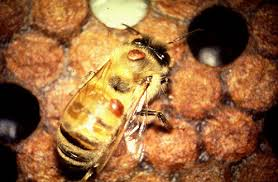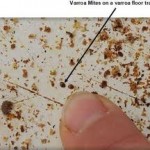We are at a stage where all colonies should be treated for varroa but if you would like to determine the actual infestation levels in your colony you can use the methods below.
The video below shows a good method as its non destructive.
Varroa destructor commonly referred to as ‘varroa’ is a highly destructive pest that can severely reduce honey production and if left untreated lead to colony collapse. Varroa is a small mite, the adult female is a reddish brown 1.1mm long x 1.5-1.6mm wide. The male is smaller (0.7mm x 0.7mm) with a yellow white colour

Female and male Varroa mites
On bees the mites are generally found between the first abdominal segments, but also between the head and the thorax and between the thorax and the abdomen. Male varroa are never found outside the brood cells.
 Methods
Methods
Natural mite fall.
Place a tray under an open mesh floor for 3-5 days and count the number of mites that fall naturally, (while not using a treatment). Treatment is necessary if the mite fall exceeds:
- Jan to Mar-2 mites/day;
- Apr to May-7 mites/day;
- Jun-Aug-8 mites/day;
- Sept-Dec-8 mites/day.
Colony collapse is imminent at the following infestation levels:
- winter-spring-1 mites/day;
- May-6 mites/day;
- Jun-10 mites/day;
- Jul-16 mites/day;
- Aug-33 mites/day;
- Sept-20 mites/day
 |
 |
Drone brood removal
During the active season, capped drone brood is removed with an uncapping fork.
Test about 100 drone larvae
Count trapped mites
<5% infestation is light, >25% infestation is severe
Production of drone brood may be encouraged by:
- Adding drone foundation to brood frames
- Leaving an empty frame for bees to produce comb
- Add super frame to brood chamber
Ether Roll test.
Select a brood frame with plenty of adult bees, and preferably with drone brood. Make sure the queen is NOT on the frame!
Gently scrape approx 300 young bees from the frame using a wide-mouth jar.
Apply a two second burst of ether (automotive starter fluid) into the jar, replace the top and shake vigorously for 30 seconds.
Gradually rotate the jar horizontally and look for any mites sticking to the sides.
Normally, the ether causes the bees to regurgitate, making the sides sticky. If not, add a bit of syrup or water.
Count the mites.
If there is no Brood: Multiply by 100 to estimate the total Varroa mite population.
if there is plenty of Brood: Multiply by 600.
Sugar Shake method.
Using pure icing sugar this is a non destructive method. Presented by Dara Scott from Advance Science.
